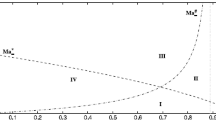Abstract
Examples of multiphase mixtures for which velocity and pressure relaxation are a stiff phenomenon are involved in many practical applications dealing with condensed phase mixtures, solid alloys, propellants and solid explosives, specific composite materials, micro- and nano-structured mixtures, etc. Shock relations for the mixture necessitate the determination of the volume fraction jump or any other thermodynamic variable jump. Examination of the shock dispersion mechanism suggests such jump relations. These relations are the phase Hugoniots which are compatible with the mixture energy equation. The corresponding model is conservative and symmetric. It fulfils the single-phase limit and guarantees volume fraction positivity. The shock relations are validated over a large set of experimental data and provide a remarkable agreement.
Similar content being viewed by others
References
Abgrall R. (1996). How to prevent pressure oscillations in multicomponent flow calculations: a quasi conservative approach. J. Comp. Phys. 125(1): 150–160
Abgrall R. and Saurel R. (2003). Discrete equations for physical and numerical compressible multiphase mixtures. J. Comp. Phys. 186(2): 361–396
Allaire G., Clerc S. and Kokh S. (2002). A five-equation model for the simulation of interfaces between compressible fluids. J. Comp. Phys. 181(2): 577–616
Baer M.R. and Nunziato J.W. (1986). A two-phase mixture theory for the deflagration-to-detonation transition (DDT) in reactive granular materials. Int. J. Multiphase Flows 12(6): 861–889
Bdzil J.B., Menikoff R., Son S.F., Kapila A.K. and Stewart D.S. (1999). Two-phase modeling of deflagration-to-detonation transition in granular materials: A critical examination of modeling issues. Phys. Fluids. 11(2): 378–402
Bushman, A.V., Lomonosov, I.V., Khishchenko, K.V.: Shock wave data base. Available on line: http://www.ficp.ac.ru/ rusbank/ (2004)
Chinnayya A., Daniel E. and Saurel R. (2004). Modelling detonation waves in heterogeneous energetic materials. J. Comp. Phys. 196(2): 490–538
Dremin A.N. and Karpukhin I.A. (1960). Method of determination of shock adiabat of the dispersed substances (in Russian). Zhurnal Prikladnoi Mekhaniki i Tekhnicheskoi Fiziki 1(3): 184–188
Gavrilyuk S. and Saurel R. (2002). Mathematical and numerical modeling of two-phase compressible flows with micro-inertia. J. Comp. Phys. 175(1): 326–360
Hamad H. and Frohn A. (1980). Structure of fully dispersed waves in dusty gases. J. Appl. Math. Phys. (ZAMP) 31(1): 66–82
Harlow, F.H., Amsden, A.A.: Fluid dynamics. Los Alamos Scientific Laboratory, University of California Press (1971)
Kapila A.K., Son S.F., Bdzil J.B., Menikoff R. and Stewart D.S. (1997). Two-phase modeling of DDT: Structure of the velocity-relaxation zone. Phys. Fluids 9(12): 3885–3897
Kapila A.K., Menikoff R., Bdzil J.B., Son S.F. and Stewart D.S. (2001). Two-phase modeling of deflagration-to-detonation transition in granular materials: reduced equations. Phys. Fluids 13(10): 3002–3024
Le Metayer O., Massoni J. and Saurel R. (2004). Elaborating equations of state of a liquid and its vapor for two-phase flow models (in French). Int. J. Thermal Sci. 43(3): 265–276
Marsh, S.P.: LASL Shock Hugoniot Data, University of California Press (1980)
Massoni J., Saurel R., Baudin G. and Demol G. (1999). A mechanistic model for shock initiation of solid explosives. Phys. Fluids 11(3): 710–736
Massoni J., Saurel R., Nkonga B. and Abgrall R. (2002). Some models and Eulerian methods for interface problems between compressible fluids with heat transfer (in French). Int. J. Heat Mass Transf. 45(6): 1287–1307
Murrone A. and Guillard H. (2005). A five equation reduced model for compressible two phase flow problems. J. Comp. Phys. 202(2): 664–698
Nesterenko, V.F.: Dynamics of heterogeneous materials. Springer, New York (2001)
Resnyansky A.D. and Bourne N.K. (2004). Shock wave compression of a porous material. J. Appl. Phys. 95(4): 1760–1769
Rudinger G. (1964). Some properties of shock relaxation in gas flows carrying small particles. Phys. Fluids 7(5): 658–663
Saurel R. and Abgrall R. (1999). A multiphase Godunov method for compressible multifluid and multiphase flows. J. Comp. Phys. 150(2): 425–467
Saurel R. and Abgrall R. (1999). A simple method for compressible multifluid flows. SIAM J. Scientific Comput. 21(3): 1115–1145
Saurel R. and Le Metayer O. (2001). A multiphase model for compressible flows with interfaces, shocks, detonation waves and cavitation. J. Fluid Mech. 431: 239–271
Saurel R., Gavrilyuk S. and Renaud F. (2003). A multiphase model with internal degrees of freedom: application to shock- bubble interaction. J. Fluid Mech. 495: 283–321
Saurel, R., Franquet, E., Daniel, E., Le Metayer, O.: A relaxation projection method for compressible flows. Part 1: The numerical equation of state for the Euler equations. J. Comp. Phys. (in press) (2006)
Saurel, R., Le Metayer, O., Massoni, J., Gavrilyuk, S.: Shock jump relations for multiphase mixtures with stiff mechanical relaxation: validations with the Mie-Gruneisen EOS. Available on line: http://iusti.polytech.univ-mrs.fr/~smash/publications.html (2006)
Shyue K-M. (1998). An efficient shock-capturing algorithm for compressible multicomponent problems. J. Comp. Phys. 142(1): 208–242
Srivastava R.S. and Sharma J.P. (1985). Dispersed shock waves in gas-particle mixture. AIAA J 23: 1817–1819
Stewart H.B. and Wendroff B. (1984). Two-phase flow: Models and methods. J. Comp. Phys. 56(3): 363–409
Author information
Authors and Affiliations
Corresponding author
Additional information
Communicated by K. Takayama.
R. Saurel, O. Le Métayer, J. Massoni and S. Gavrilyuk also belong to INRIA SMASH Project.
Rights and permissions
About this article
Cite this article
Saurel, R., Le Métayer, O., Massoni, J. et al. Shock jump relations for multiphase mixtures with stiff mechanical relaxation. Shock Waves 16, 209–232 (2007). https://doi.org/10.1007/s00193-006-0065-7
Received:
Accepted:
Published:
Issue Date:
DOI: https://doi.org/10.1007/s00193-006-0065-7




